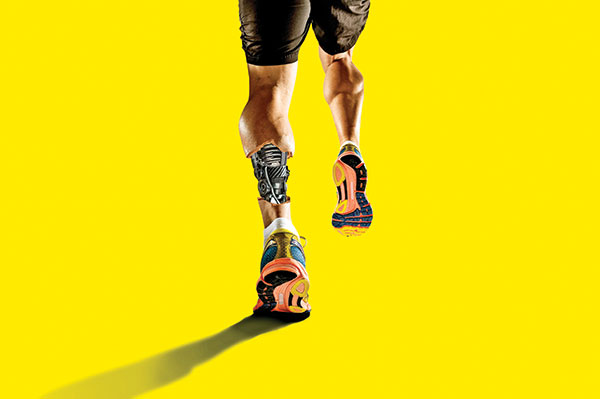Gym equipment adapts real world exercise into something that can be enjoyed in a controlled environment. We examine what you’re losing and gaining by performing the exercise in its unintended state.
The question is: are you becoming weaker by working in the gym rather than outside or performing exercises in their more natural state?
Exercise bike vs cycling outside
The gain: Their advantages stem from being able to lock down the variables and isolate one aspect of your performance for improvement. Going flat out to increase your workout intensity with constant power cycling can only really be achieved on stationary bikes. Consequently, you also gain a measure of safety on a static buke that you simply don’t have cycling outdoors.
The loss: You really can’t beat the real thing, because bicycles require more total body exertion. While your legs still do the brunt of the work, your whole core will be tested since you’ll be using it to maintain body balance outdoors.
Standing or sitting will also be required when you’re altering your speed, and the Journal of Strength and Conditioning Research found that outdoor cycling allows cyclists to exercise at a far higher intensity. Training indoors exclusively can also result in some muscles being overworked, while underworking others.
For example, your hamstrings work harder when training indoors to slow down the pedals when decreasing your speed, the total opposite of riding outdoors where pedaling against the friction of the road coupled with the additional wind resistance will ask more of your quadriceps and hip flexors.
Finally, tackling new terrain is something that no amount of indoor training can ever prepare you for. Confronting a real world hill means your bike moves underneath you, as does its angle, and your seating position.
The verdict
Indoor training can certainly be a helpful and safer addition to your cycling arsenal, but you’ll leave extra fat burning calories at the door. The majority of your cycling should be on the roads but indoor spinning sessions one or two times per week can provide the social and extra motivation to burn those extra calories that stand alone gym bicycles leave behind.
Treadmill vs Running

The gain: Treadmills offer consistent terrain with less stress on your bendy bits. Consistently plodding along on unforgiving concrete surfaces can add repetitive impact to your joints, accounting for 75% of all running injuries, according to the Sports Medicine Journal.
For anyone with a spot of OCD, the ’mill also provides a consistent environment to measure progress by controlling for variables like speed, incline and time.
Finally, running outside is not always possible, especially if it’s colder than a mother in-law’s love or hotter than her scorn.
The loss: Evading drops of rain comes at a price as a change in gait – specifically, a change in stride length from running repetitively on the treadmill – sees your strides getting longer. Looking at the mechanics of a sprinter like Bolt, this sounds ideal, right?
Steady on, as a paper in the Journal of Strength and Conditioning found this was simply because the ground under your feet is continually moving on a treadmill. This meant runners were shifting effort towards the back of their legs (hamstrings) and their foot was striking the ground further toward their heels.
While this steady change in technique over time aids your sessions, it can be a disadvantage when running on terra firma and will mean burning fewer calories if you’re interval training. “On treadmills, the conveyor belt moves towards you and you stay in the same place,” explains calisthenics expert trainer, Al Kavaldo. “All you do is lift your foot. You don’t actually propel yourself forward.
This makes it less work, giving you a false sense of your actual fitness level. Worse yet, treadmills can foster poor running mechanics.” This means your potential for injury is increased.
The verdict
If you’re mindful of the treadmill’s limits and strength train regularly to keep your ligaments strong then it is a valid way to keep fit for your running sports. Try to hit a 50:50 ration of treadmill to outdoor running because running or sprinting against wind will have a big boost for your performance while making you burn more calories. Save the treadmill for rainy day activity, you’re not a hamster on a wheel.
Rowing machine vs rowing outside
The gain: Rowing machines actually offer a huge boost to a rower’s training and performance increases. Commonly, the competitor who sprinkles indoor rowing training in with more practical outdoor rowing will have a huge advantage in power and fitness over the rower who balks at the idea of training indoors.
Olympic champions like Mahé Drysdale and Kim Brennan use a dynamic rower like the RP3, achieving tremendous scores on the indoor ergometer, which has translated to real world Olympic success. Again, your use of the indoor machine should isolate an area of your game that you want to improve your rowing game such as power or VO2 max.
The loss: Static rowers like the Concept2 machines often put an immense amount of stress on your lower back. Also, “ergs don’t float” is a common rebuttal when a fellow rower brags about their achievements on a machine, which points to the balance and resulting core strength requirements demanded when you’re on water – absent on a static machine.
Commonly, a rower who does most of their work inside the boat edges a competitor with a higher score on the indoor machine due to technique differences and inefficiencies. However, turning your nose up at indoor training means you’ll tend to be beaten by a competitor who works on their power and fitness in an isolated indoor environment as well as putting in the kilometers on the water.
The verdict
Machines are truly a progression in training for the advancement of the sport. The outcomes of most major events point to a combination of indoor and outdoor rowing for performance. For fat loss, many turn resistance dials to 10 but the folk at Concept2 say: “The real challenge is to accelerate the flywheel at a lower setting, where power must be applied.”
Elliptical vs everything
The gain: Elliptical machines have a bad wrap but there’s plenty of contrary evidence because there’s a reason they’re being compared to everything. When used correctly, it can provide you with just as much fitness for the sport you’re training for, without the strain on the joints.
A paper in the Journal of Strength and Conditioning Research looked at the treadmill vs the elliptical and found that energy expenditure and gains made in fitness didn’t differ between the two. Not content with being a replacement, ellipticals also improved quad and glute activation alongside the external hip muscles – helpful for enhanced performance in sports like running or cycling. This machine provides more activation for these muscles than walking and cycling, so can be complementary to just about every sport.
Finally, how about melting some extra fat for free? A paper in Medicine & Science in Sports & Exercise found taking longer strides on an elliptical meant more calories burned without increasing perceived exertion.
The loss: As with many machines, the stationary nature of the elliptical will not be comfortable for all of our unique human structures. Even when you do find one that you’re happy with, you’ll need to contend with the fact that calorie calculations on ellipticals were found to be inaccurate in most machines shown in Research Quarterly for Exercise and Sport.
The verdict
They’re a solid choice for crosstraining in the off-season or for injured folks to maintain and even progress their fitness without impacting the joints. Beware of inaccurate calorie calculators when your goal’s fat burning, though.
Free-weights vs resistance machines
The gain: Being stable and locked down into a resistance machine means you’ll achieve more muscle activation for your prime movers. The reason for this is that your stabilizing muscles don’t need to be as active for balance. The gain here is better isolation.
Dr Kraemer and Dr Fleck, authors of Strength Training For Young Athletes add, “This ability to isolate a muscle group is ideal for some rehabilitation routines after an injury, or when the goal is to increase strength/power, local muscular endurance of a muscle group/ joint that is prone to injury or is the weak link in performance.”

The loss: There are endless body types. Rarely does one machine fit all, so your first loss is natural movement range. Much of the research points to the strength gained by free weight training to be more beneficial. For vertical jumping ability, free weight squats were found to be superior, probably because of the mechanical similarity to jumping.
Perhaps the most telling study from the Journal of Strength and Conditioning was that, in 16 weeks, free weight users achieved a 58% jump in strength and a whopping 196% increase in balance over fixed machine users.
The verdict
While it sounds like free weights are the way forward, depending on the sport, scenario and purpose, machine resistance can be used to complement your training. “Selectorized fitness equipment movement patterns are not natural and will have less carryover into real life activities than calisthenics exercises,” explains Kavadlo.
“If everything you do for your workout involves sliding a fixed piece of machinery along a predetermined path, you’re just going through the motions. You’re not truly creating movement.” For bodybuilding, taking the smaller stabilizer muscles out of the equation can be both a positive and negative.
Stair climbing vs stairmaster
The gain: Not everyone has nearby stadium access to run stairs and most shared stairwells aren’t all that accepting of fitness efforts. Imagine the sneers if you tried it on the subway stairs. Therein lies the obvious convenience of the Stairmaster, which also allows for cardio and lower body resistance work in people who have injuries that are alleviated by reducing range of motion, but what about what goes on under your hood?
A paper in Biomechanics of Human Movement compared stair climbing and the Stairmaster to find that the former required a larger range of motion and more time to complete one movement cycle (2.57 seconds vs 2.15 seconds for the Stairmaster).
Although the knee joint experienced an almost identical range of motion in both modes of exercise, the hip joint needed much less movement to complete a repetition of the Stairmaster, which is much safer for those rehabbing a dodgy hip but real stairs are better for culling calories.
The loss: The significantly reduced range needed to complete one cycle of the Stairmaster – 17% less than real stair climbing – means that it can’t compete with the intensity of sprinting up those park stairs. When you push down on the machine, your other leg is lifted for you by the machine.
This difference in technique helps reduce the force necessary by the hips and thighs; while this lessened force and impact is good for those coming off an injury, consistently using this machine is likely to cause weaknesses in the missing ranges of movement in the hips and thighs.
Adding insult to injury, this is a machine that completely isolates your lower body, meaning not only a lesser calorie burn due to no upper body movement, but potentially interfering with your lower body weight training performance, too.
Cardio modes that require more effort by your lower body carry negative interferences on strength performance, found a paper in the Journal of Strength and Conditioning. So it’s probably not the ideal bit of equipment, then, that bodybuilders slaving away on them for their contest prep would lead us to believe.
The verdict
The Stairmaster is a double-edged sword that will please fans of stair climbing who don’t live near a suitable flight of stairs. Simultaneously, it won’t provide quite as effective a workout. “There is a trade-off between the two movements,” explains Anne Elliot, the co-author of the study for the Biomechanics of Human Movement. “Stair climbing is the most effective in providing a quality workout and use of the Stairmaster minimizes the risk of injury,” summing it up perfectly. Climbing the stairs is riskier but will fry more calories and get you leaner.
Overall, it’s not as cut and dry, like most things in fitness, as one mode being superior to the other. As you can see, there are pros and cons to both and using this piece to make an informed decision on which mode of exercise to perform will be your first port of call.
Spoiler alert: optimum progress in your training often lands somewhere in the middle and a mixture of both machinery and au naturel are what will often yield perfectly baked fitness results.
For more articles like Man vs Machine, nutrition tips, and interviews, get TRAIN magazine direct into your inbox every month for free by signing up to our newsletter







